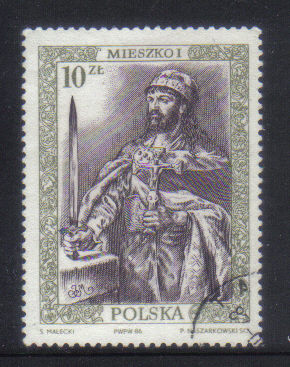
His son Boreslaw i Chobry established a Polish church province and was officially crowned the first King of Poland, in 1025.
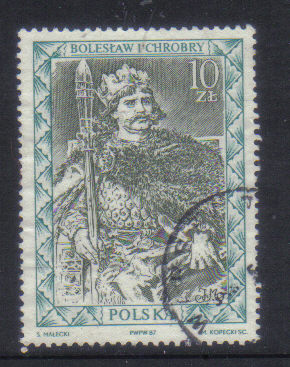
 | The history of Poland goes back a long time. The historicly recorded Polish State began in 966 AD with the rule of Mieszko I. His son Boreslaw i Chobry established a Polish church province and was officially crowned the first King of Poland, in 1025. |  |
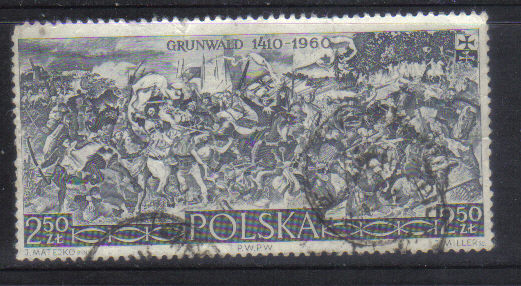 | The personal union between Poland and Lithuania, which took place in 1386 made them powerful allies, who even defeated the Teutonic Knights at Grunwold in 1410. This Union grew into the Polish-Lithuanian Commonwealth in 1569. |
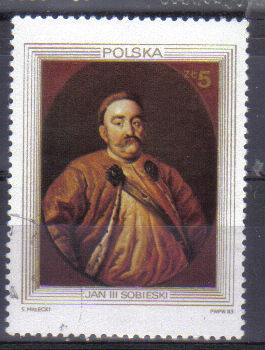 | This Commonwealth became a strong military power, which fought against Sweden, Russia and the Ottoman Empire. It stretched from Posen in Prussia to Smolensk in Russia and from Estonia to Kiev in the Ukraine, but through internal disorder it gradually declined. Ruler John III Sobieski revived the military might once more by helping to defeat the Turks in front of Vienna and so saving Christianity in Europe. Constant wars with her neighbours later, resulted in so much territory loss that after three partitions the Polish-Lithuanian Commonwealth ceased to exist in 1795. The country was divided by Russia, Prussia and Austria. And so was the situation in 1914. | 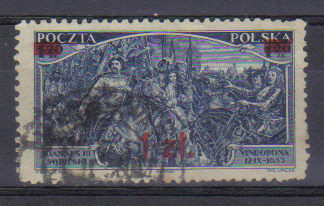 |
| To relieve the pressure on the Western Front for the French, the Russian army advanced into East Prussia, earlier than the Germans had anticipated. After sending reinforcements to the border and changing command to General von Hindenburg, the Czarist army was defeated at Tannenberg in March 1915. A great morale booster for the Germans, who still remembered the defeat at Tannenberg (Grunwold in Polish) in 1410, by the Polish-Lithuanian forces. |  |
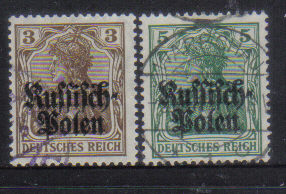 | After the German army defeated the Russians at the battle of Tannenberg in March 1915, they had chased the Russians out of Russian Poland by September 1915.The German "Germania" stamps were overprinted with "Russisch Polen" (Russian Poland). They were replaced in August 1916 with the "Germania" stamps overprinted "Gen-Govn Warschau" (General government Warsaw). |  |
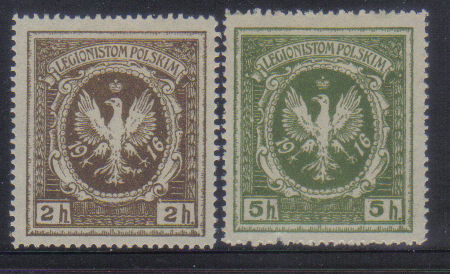 |  |
| --- | The Polish Legion was the name of Polish armed forces, created in August 1914 in Galicia (Austrian Poland). This unit became an independent unit in the Austrian-Hungarian army.The Legion took part in many battles against Czarist Russia, both in Galicia and in the Carpathian Mountains. | --- |
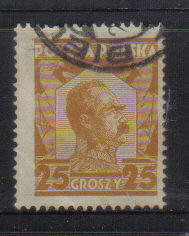 | Colonel Joseph Pilsudski formed the 1st Brigade of the Polish Legion. (Poles fought in the armies of Germany, Russia and Austria-Hungary and lost over 1.1 million military and civilian people in the war.) On the right we see Pilsudski and his Legion. |  |
 | As the whole of Russian Poland became occupied by the Central Powers, they created "the Kingdom of Poland " out of this. This puppet state existed until November 1918 and was then replaced by the newly established Second Republic of Poland. |
 | The Kingdom of Poland overprinted not only the "German Polish stamps", but also the feldpost stamps of the Austrian-Hungarian Empire and her warcharity issues. |  |
 | The first official postage stamps issued by the new Republic of Poland in Warsaw on November17,1918 were local Warsaw stamps, overprinted with Fen currency and Poczta Polska. (100 Fenigy = 1 Marka, currency for Northern Poland). |  |
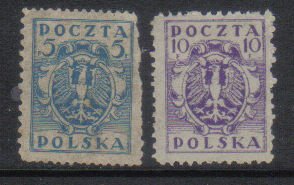 | Later 2 sets were issued that were simular in design, but one was in Fenigow currency and the other in Halerzy currency. The latter being for southern Poland, that came from Austrian-Hungarian territory. |  |
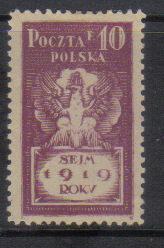 | In 1919 Liberated Poland celebrated its first session of Parliament with a special set of stamps. One featuring the Polish Eagle and the other the first Prime Minister Paderewski. |  |
 | Although the Republic was recognised, her borders were not really defined. So when Soviet Russia decided to claim back some of the lost territory, heavy fighting broke out, which finished, when marshal Pilsudski defeated the Russian general Tukhachevski, in the battle of Warsaw. | 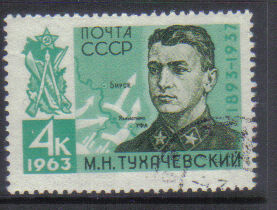 |
 | This district, before 1914, was known as East Galicia and was part of the Austria-Hungararian Empire. It achieved temporary independence after the war as "West Ukraine", before it became part of Poland in June 1919. |
 | Posen, originally Polish, had become Prussian after the partition of Poland in 1793. It became officially German in 1848, but still had a Polish majority. On December27, 1918 the Polish citizens in Posen started an uprising against the German Authority. Fighting continued until June 1919, when the Treaty of Versailles gave the Duchy of Posen to Poland. The German stamps there, were overprinted "Poczta Polska". |  |
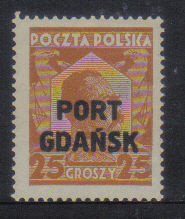 | Apart from the Duchy of Posen, the Treaty of Versailles also gave Poland a corridor through Prussia to the newly created "Free city of Danzig". This way Poland had access to a seaport and special stamps were overprinted for this. |  |
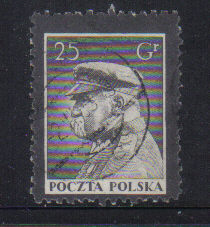 | Marshall Pilsudski, apart from being a great war hero, also became a great statesman. A special mourning stamp was issued after May 12, 1935 and in Krakow, work started on a special mound (Pilsudski mound), where soil from every battlefield, where Poles had fought, was placed. This mound was finished on July 9, 1937 and a special overprint was applied. | 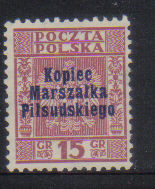 |
 | After the October Revolution in Russia, the Bolsheviks, in the peace treaty of Brest-Litovsk, surrendered the Baltic provinces, including Poland's former partner Lithuania, to the Germans. The new masters used for postal purposes their Germania stamps with the overprint: "Postgebiet Ob(ercommando) Ost". | 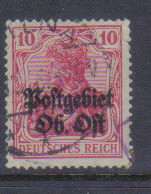 |
 | In the 1916 German census of the Vilnius Region (the historical capital of Lithuania was Vilnius) was 58% Poles and 18.5% Lithuanians and after both countries became independent, a conflict arose. In October 1920 Polish General Zeligowski with an army and local Polish inhabitants occupied Vilnius and created a new state: "Republic of Central Lithuania" (Litwa Srodkowa). In 1922 the area was annexed by Poland. |  |
 | Lithuania never agreed to this annexation, but the Allies soften the blow by awarding Lithuania the Prussian port and industrial area of Memel, which was occupied by French troops. The area was then renamed "Klaipeda" as these overprinted and later Lithuanian stamps show. | 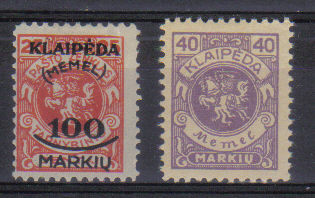 |
 | Another area that Poland laid claims to, was Eastern Silesia.Polish stamps were overprinted with S.O (Silesie Orientale) prior to a plebiscite. This was never held and the area was divided between Poland and the newly created state of Czechoslovakia in 1920. |  |
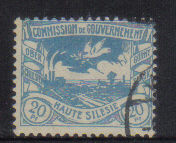 | A plebiscite in Upper Silesia, organised by the Allied Commission, divided the area between Germany and Poland. |  |
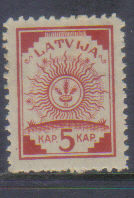 | Latvia had been a Russian possession since 1795; after the October revolution in Russia in 1917, the country plunged into chaos. The fighting between German and Russian troops was followed by fighting between pro-communist forces against White Russian. Order was restored by the "Landwehr" a pro-German military force, commanded by a British officer who liberated Riga (the Capital) in May 1918. A National Council was then established and Latvia declared her Independence. Here we see the first stamps of independent Latvia. | 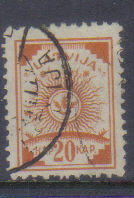 |
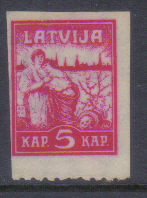 | This stamp was issued to commemmorate the liberation of Riga in 1918. It really portrays the high price, that was paid for it. |
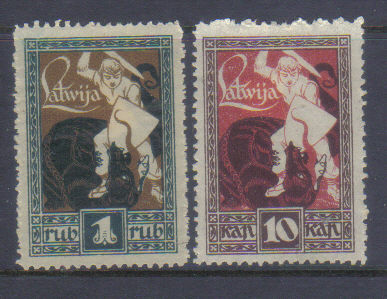 | These were issued to commemmorate the liberation of Courland and we see a young knight kill a (Russian?) bear. |  |
 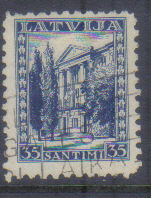 | These stamps were issued on the 15th anniversary of the new constitution |  |
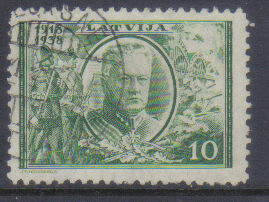 | And on the stamps, issued for the 20th anniversary of Independence, we see on the left General J.Balodis, the Commander in Chief during the Independence struggle and on the right the first President Ulmanis. | 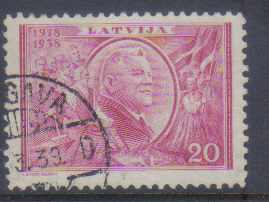 |
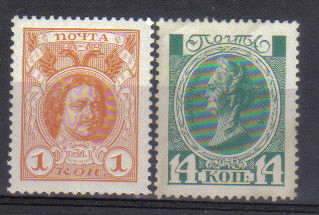 | In 1913, just before the war, Russia issued a serie of stamps featuring the "Romanov" dynasty,from Peter the Great and Catharina the Great to the last Czar Nicholas II. |  |
 | In 1914 /15 the war charity stamps appeared. One featuring a Russian hero, Ilya Murometz and the other a symbolic Mother Russia surrounded by her children. |  |
 | Then in October 1917 came the revolution and that was shown by a sword breaking the chains. |  |
 | The revolution in 1917 was really a continuation of the revolt in 1905, when a peaceful demonstration, whereby 150.000 people took to the streets to protest about their standard of living , was met by nervous troops who opened fire. After the firing had stopped, several hundred people lay dead. Vladimir Lenin went into exile after this | 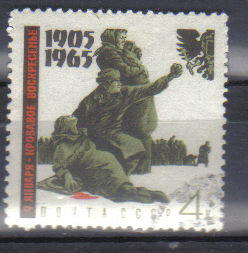 |
 | Vladimir Ulyanovsk, better known as Lenin, was born in Simbirsk, (city 893 km east of Moscow and in 1924 renamed Ulyanovsk). He became a Marxist follower, when he studied at Kazan University and was exiled to Siberia for three years. Lenin lived in Switzerland in 1917 and made a deal with the Germans: If they could smuggle him back into Russia, he would try and take Russia out of the war. They smuggled him in a cattle truck into Russia and Lenin arrived to a hero's welcome. | 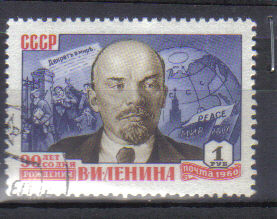 |
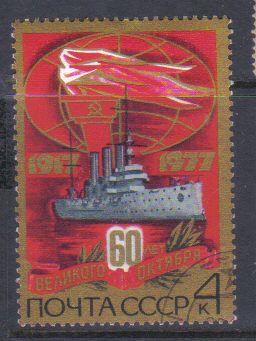 | On October 25,1917 the crew of the cruiser "Aurora" mutinied and when a blank shot was fired from her guns, it signalled the assault on the Winterpalace. | 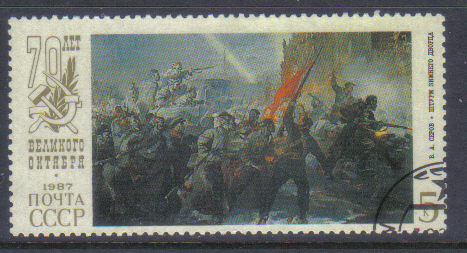 |
 | The Czar had abdicated earlier and this assault signalled the end of Czarist Russia and heralded the Bolsheviks as the new leaders in Russia. | 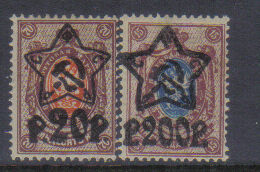 |
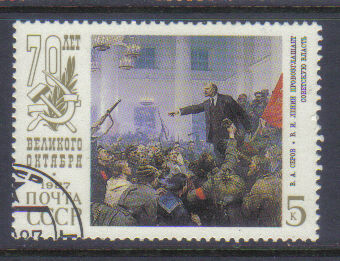 | The counsel of People's Commissars on November 15,1917 installed Vladimir Lenin as Leader of Russia and proclaimed the right of self-determination of the nationalities, that were included in the Czarist Empire, but it hoped that they would remain with Russia. |  |
 | Finland, which had been a Duchy in Czarist Russia, declared her independence a month later. On the left we see a Czarist Russian stamp that was used in Finland with Finnish currency and the other is the new Finnish stamp. |  |
 | Estonia was handed over to the Germans at the Treaty of Brest-Litovsk, but declared her independence after the armistice in November 1918. The Bolshevik Red army then tried to recoup the territory, but were defeated in January 1919. Estonia issued stamps to support her wounded soldiers. |  |
 | The Ukraine, which had also been a part of Czarist Russia, declared her independence in November 1917 and demonstrated that by overprinting Russian stamps with the Ukrainian trident. | 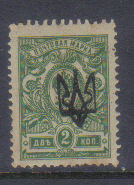 |
 | These were later replaced by regular Ukrainian stamps. | 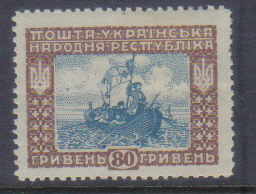 |
 | At the Peace of Riga in 1921, West Ukraine became part of Poland and the Eastern part became the Ukrainian Soviet Socialist Republic. |
 | Georgia issued these stamps until they were invaded by the Red army and made into a Soviet Republic in 1920. | 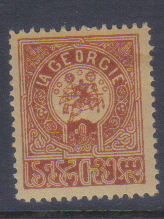 |
 | Azerbeijan issued stamps with a standard bearer and the citadel Baku in her independent period from May 1918 until April 1920. |  |
 | Once Azerbeijan became a soviet republic, she issued stamps featuring her greatest assets. Her oilwells and the Bibi Eibatt oilfield. |  |
 | As resistance to the Bolsheviks increased, Lenin considered the Czar a great symbol for the White Russian forces. He therefor had the whole family moved to Jekaterinburg in the Urals and had them murdered by the secret police in July 1918. The bodies were disposed off in an unused mineshaft, where they were not discovered until 1992. |
 | Because of the anti-peasant policy of the Bolsheviks, a great famine and inflation was created in the Volga districts. These stamps were issued in 1921 to relief some of the tragedy. |  |
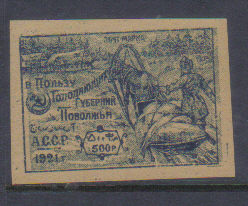 | Azerbeijan also issued special relief stamps. |  |
 | And Georgia did the same. |  |
 | Joseph Stalin was born in Gori, Georgia in 1879. He was a bright student, who earned a scholarship for the priesthood. While there, he read Karl Marx's "Das Kapital" and converted to Marxism. In 1914 he was exiled to Siberia and returned to St. Petersburg in 1917. He then became one of Lenin's administrators. After Lenin died, Stalin suppressed Lenin's political testament, wherein Lenin had expressed doubt, that Stalin would be able to rule with sufficient caution. Through manipulations, intrigues and assassinations, Stalin managed to become Russia's Leader until he died in 1953. |
 | Mikhail Tukhachevsky graduated from military school in 1914. He was taken prisoner by the Germans in 1915, but escaped 5 times. His last escape was successful and he came back to Russia in 1917. He was of noble ancestry, but joined the Red army and during the civil war, he was as ruthless as any Bolshevik and even used poison gas on peasant uprisings. He commanded the Soviet invasion of Poland during the Polish-Russian war in 1920, where he was defeated by Joseph Pilsudski outside Warsaw. It was then, that he first came into conflict with Stalin, who had him executed for treason in 1937. (Stalin purges) |
| Mikhail Frunze was a Bolshevik leader, prior and during the revolution in 1917. He became a military commissar in 1918 and during the early days of the Civil war was appointed Head of the Southern army. It is suspected, that he was poisoned with chloroform during an operation, on Stalin's orders in 1925. | 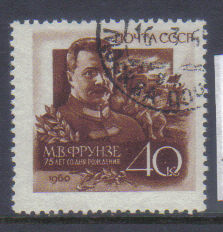 |
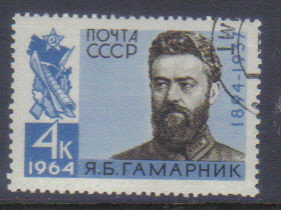 | Yakov Gamarnik became secretary of the Kiev committee of the Communist party of the Soviet Union in 1917. He was a staunch supporter of Mikhail Tukhachevski, but killed himself before Stalin could have him also tried and executed on treason charges. |
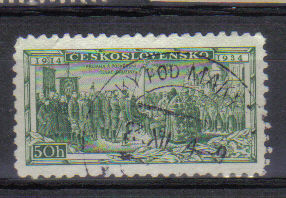 | There was also a lot of political activity on the Eastern Front. Where as the Germans had smuggled Lenin back into Russia and the Central Powers had created a Polish Legion, the Czar had recruited a Czechoslovakian Legion out of prisoners-of-war and Czech and Slovak nationalists. In 1914 many Czech- and Slovak-patriots left the Austrian-Hungarian Empire and joined the Russian Army to fight the Central Powers and formed the Czechoslovakian Legion. Here we see the “consecrating of colours” in Kiev. |
 | Also in France was a Czechoslovakian Legion formed. On the left we see a Legionair holding the flag of the newly formed Legion and on the right a French, Serbian and Czechoslovakian soldier. |  |
 | The Czech Legion in France was originally called "Nazdar" in 1914. (Nazdar is hello in English and is used as a greeting by members of the Sokol movement). The Sokol movement is a youth sport and gymnastic organisation, organised in 1862 by Dr. Miroslav Tyrs (left) and Jundrich Fügner (on the right). Although it is classed a forerunner of scouting and was supposed to be above politics, it played a mayor role in Czech nationalism. |  |
 | Early in the war, the Battle of Arras was an attempt of the French to outflank the Germans in a north westerly move towards the English Channel and the Czech "Nazdars" distinguished themselves in this battle. (Later called the race to the sea). These stamps commemmorate the sacrifices, that the Czechs made. | 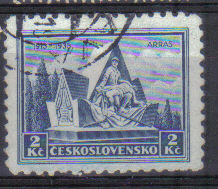 |
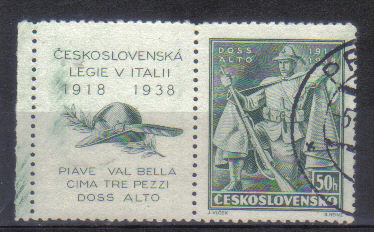 | The Czechs also fought on the Italian front. The Czech Legion replaced the Italian Army at the trenches protecting Monte Altisino di Nago, on the Austrian border, in August 1918. In September, they successfully defended the positions and as a result the Austrian border was replaced 130 km to the north. |
| Once the Czechoslovakian National Council in Paris was recognised as a co-belligerent, the Czech legion fought as a national army. One of the last battles on the Western front, was at Vouziers, which this stamp shows. | 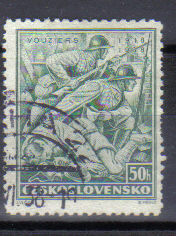 |
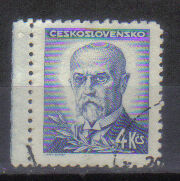 | Thomas Garrigue Masaryk was born in Moravia and became an eager advocate of Czechoslovak independence. During 1914 he went into exile and organised Czechs and Slovaks in Switzerland, France, Great Britain, Russia and the USA. In the US he convinced President Woodrow Wilson of the rightness of his cause for a Czechoslovakian independence. His was one of the signatures of the Declaration of Independence in November 1918. |
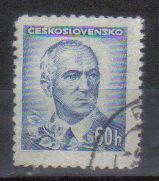 | Edvard Benes was born in Bohemia and one of the leading organisers of an independent Czechoslovakia. In 1915 he went into exile, where in Paris he became Secretary of the Czech National Council. As such he was able to make diplomatic efforts to gain support for independence from France and Great Britain. His was also a signature on the Declaration in 1918. Another important member of the National Council was the Slovak born General Milan Stefanik. | 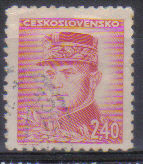 |
 | The history of the Czech Legion on the Eastern front is a very interesting one. Here we see the Battle of Zborov commemmorated, which was the first significant action of the Czech Legion and the only successful action of the last Czarist offensive (Kerensky offensive). Although the offensive failed, the battle gave much political capital to the Leaders of the Czechoslovakian resistance. |  |
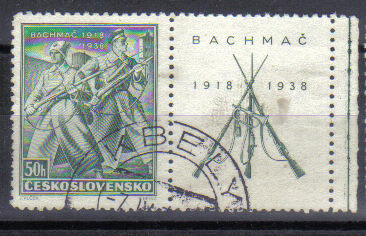 | The Battle of Bachmac changed the purpose of the Czech Legion in Russia. At the Treaty of Brest-Litovsk, the Bolsheviks had agreed to surrender the Legion to the Central Powers. If they had surrendered, the Legion would have faced certain execution as technically they were Austrian citizens. So when the Red army encircled them at Bachmac, they fought themselves out of that and escaped by train to Vladivostov, where they joined the White Russian army. They took Vladivostok for the Allies in July 1918. During their escape to the east, they captured 8 wagons with Czarist gold, which they later handed to the White Russian army. (Rumours later circulated, that they kept one wagonload of gold for themselves, with which the Central Bank in Czechoslovakia started business.) It took three years before the last Legionair arrived back in Czechoslovakia from Russia. |
 | In 1919 the Legion was honoured with a special set of stamps, where we see the lion breaking his chains. | 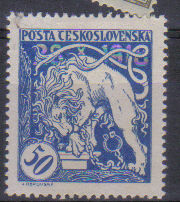 |
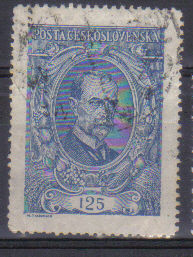 | The new independent state of Czechoslovakia was born on October28, 1918, with Thomas Garrigue Masaryk as its first President. |  |
 | Exactly 12 months later, a set of stamps was issued, showing a mother nursing her new baby. | 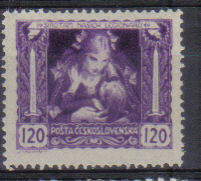 |
 | The first definitive stamp issue of the new republic was not a great success. It was supposed to show Hradcany Castle in Prague with a rising sun behind it. The sun here shown turned out to be a setting sun and that was classed as a bad omen. So a new set appeared with the sun omitted. |  |
 | The borders of Czechoslovakia were not all defined and an area that Poland also laid claims to, was Eastern Silesia.Czechoslovakian stamps were overprinted with S.O (Silesie Orientale) prior to a plebiscite. This was never held and the area was divided between Poland and Czechoslovakia in 1920. |  |
 | In the newly created state of Czechoslovakia, there were great stocks of stamps of the previous Governments. These stamps were overprinted with :"Posta Ceskaslovenska 1919" and sold with a 50% surcharge for charity. On one side we see Austrian stamps from Bohemia and Moravia, while the greater part of Slovakia was Hungarian. |  |
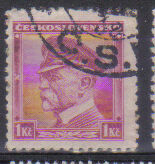 | And so the new State of Czechoslovakia was created with Thomas Masaryk as the first President and Edvard Benes the first Premier. |  |
 | When the war broke out in 1914, Romania remained neutral. Although she had a pact with Austria-Hungary, she choose to remain neutral for the same reason as Italy did. (Austria starting an agression war) King Carol I belonged to the House of Hohenzollern (as did the German Kaiser) and wanted to join the war on the side of the Central Powers. Public opinion and political parties were in favour of joining the Allies. By joining the Allies, Romania hoped to gain Transylvania from Austria-Hungary and Dobruja from Bulgaria. |
 | So on August 13, 1916 Romania declared war on the Central Powers, but after the October revolution in Russia, she was isolated and very soon overrun by the Central Powers. |
 | Initially the German occupiers issued Germania stamps overprinted with "M.V.i.R" {Militärverwaltung in Rumänien (Military Government in Romania)} in June 1917. |  |
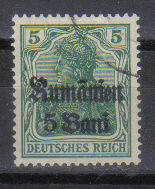 | These temporary stamps were followed in 1918 by stamps of a more permanent nature, which were overprinted "Rumänien". |  |
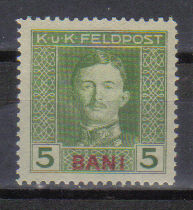 | The other partner of the Central Powers, Austria-Hungary used her Feldpost stamps overprinted with Romanian currency in her occupied territory. |  |
 | The Austrian overprinted feldpost stamps were also soon replaced by more permanent ones. Romania was forced to sign the Treaty of Bukarest with the Central Powers on May 7, 1918, but on November 10 she re-entered the war and played an important part in the post war history of Hungary. | 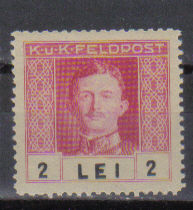 |
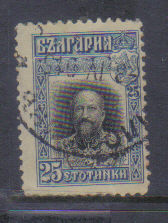 | In 1914, when the war broke out, Bulgaria was recovering from her defeat in the last Balkan war, when she had to surrender much territory to Serbia, Romania and Greece. Seeing the initial success of the Central Powers, Czar Ferdinand decided to join them and declared war on Serbia on October15, 1915. |  |
 | Bulgaria, although being the smallest of the Central Powers, was very important, because of her geographical position. Through her the Ottoman Empire could be supplied with assistance. She was engaged in some very successful engagements against Serbia and Romania, but when she took part of Macedonia, the front became entrenched. These stamps were issued to commemorate the liberation of Macedonia. |  |
 | Because of the stalemate at the Macedonian front, the Allies were able to build up forces in Thessalonika under command of the French General Louis Etiene d'Esperay. When they went into offensive, the Bulgarian defense collapsed and Bulgaria asked for an armistice on September 29, 1918. 4days later Czar Ferdinand, who had just celebrated his 30th anniversary on the throne, abdicated and left Bulgaria to his heir Czar Boris lll. |  |
 | Thrace, which is a very important area, covering Southern Bulgaria, Eastern Greece and the North of Turkey, was occupied by Allied forces. |
 xxxxxxxxxxxxxxxx
xxxxxxxxxxxxxxxx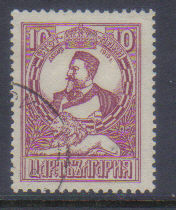 xxxxxxxxxxxxxxxx
xxxxxxxxxxxxxxxx
 | This set of stamps was prepared in 1915 to commemorate the annexation of Macedonia, but were not issued until 1921. After protests of the newly created Kingdom of Serbs, Croats and Slovenes, they were only on sale for three days and then withdrawn. |  |
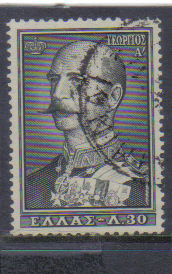 | King George l (on the left)was assassinated in Thessaloniki on March 13, 1913 and that brought his son King Constantine to the throne. King constantine was the first Greek King born in Greece and Greek orthodox. He was educated in Germany and married with Sophia of Prussia, the sister of the German Kaiser. He was convinced of a Central Powers' victory. When the war broke out in 1914, Greece remained neutral, although the prime minister, Eleftherios Venizelos, wanted to join the Allies. | 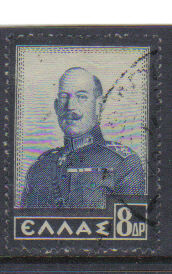 |
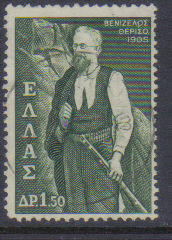 | Eleftherios Venizelos first made a name for himself as the leader of a rebellion against Ottoman occupation of Crete. Later in 1909 he was invited to Greece by disgruntled Army officers to form a government. He became Prime Minister after the election of November 1910. He was Prime Minister from 1910- 1920 and from 1928-1932. When the war broke out, he realised that Greece as a maritime nation could not afford not to support the Allies (the dominant naval power in the Mediterranian). He urged the King to allow Greek participation on the Allies side. After he permitted Allied troops to be landed at Thessaloniki, without the King's permission, he was fired by the King. | 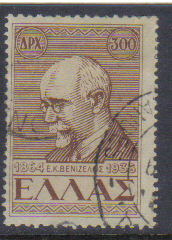 |
 | In August 1916, Venizelos declared a provisional government in Thessaloniki and this break within Greece, has later been named :"The National Schism". Venizelos had stamps printed that were inscribed: "Provisional Government". | 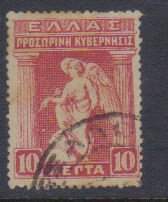 |
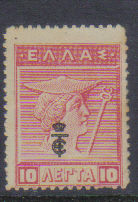 | The area around Athens was still loyal to the King and the stamps in use there, were overprinted with the Royal Cypher. The Allies told the King to abdicate or Athens would be bombed. In 1917 King Constantine abdicated and as the Crown Prince (the later King George ll) refused the crown, King Alexander, the youngest son, became King. |  |
 | At the end of the war, as the Ottoman Empire was defeated, Geek forces occupied Eastern Thrace and Greek stamps were overprinted with "Greek Administration" (Left). On the right hand side we see Greek stamps overprinted with" High Commission of Thrace", the commission that decided the future of the rest of Thrace. |   |
 | Here we see Prime Minister Venizelos signing the Treaty of Sèvres. The Treaty of Sèvres was signed with representatives of the Ottoman Empire, but a revolt in Turkey caused a refusal to ratify the document. It was not until a new treaty, the Treaty of Lausanne was signed by all parties that peace was restored. |
| This Ottoman overprinted stamp commemmorates the return of Adrianople to Turkey. Adrianople is a very old city and was founded by the Romans and called Hadrianapolis. It was on a very important route to the East and even now it is close to the Bulgarian and Greek border. It is still a very important city in modern Turkey and called Edirne. | 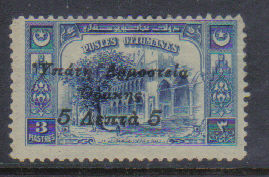 |
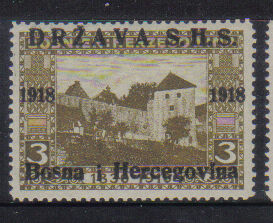 | The first stamps of the new Kingdom were for Bosnia-Herzegovina and were overprinted with DRZAVA SHS 1918 1918. | 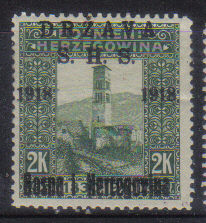 |
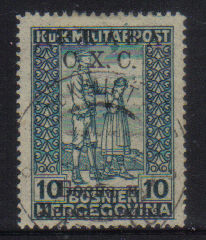 | Even the old Austrian-Bosnia war charity stamps were overprinted with the new name of Kingdom S(erbs) H(Croats) S(lovenes). | 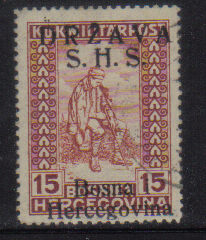 |
 | Croatia, that had been part of Hungary, issued the overprinted Hungarian stamps at first. | 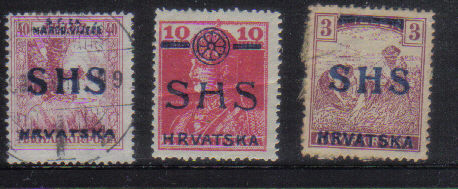 |
 | These were later followed by more definitive stamps, such as the angel of peace and a sailor with standard and falcon. | 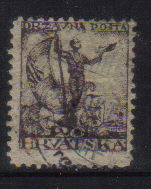 |
 | The stamps, that Slovenia issued to commemmorate her freedom, portrayed the breaking of chains. | 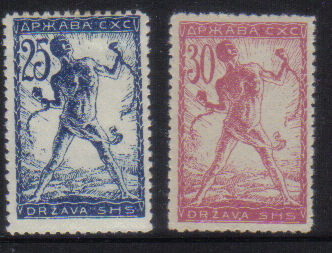 |
 | It was not until 1921, that the first definitives for the whole of the new Kingdom of Serbs, Croats and Slovenes appeared, with the King of Serbia, King Peter l of Serbia as King, while some of the stamps featured King Alexander, when Crown Prince. |  |
 | Stamps were also issued for the Disabled Soldiers fund. One shows a scene of a Korsovo Maiden helping a soldier and the other a wounded soldier retreating through Albania. |  |
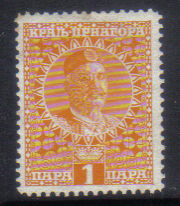 | Montenegro declared war on the Central Powers, when Serbia was attacked in 1914. Her forces fought with the Serbians, but when Serbia was invaded by the 3rd Austrian-Hungarian and German armies and overrun, Montenegro was also occupied in January 1916 and remained so till the end of the war. King Nicholas fled to Italy and then to France, where a Govenment-in-exile was set up in Bordeaux. Later the King was deposed after he was accused of seeking a seperate peace with the enemy. On December 1, 1918, Montenegro joined the Kingsom of Serbs, Croats and Slovenes. |  |